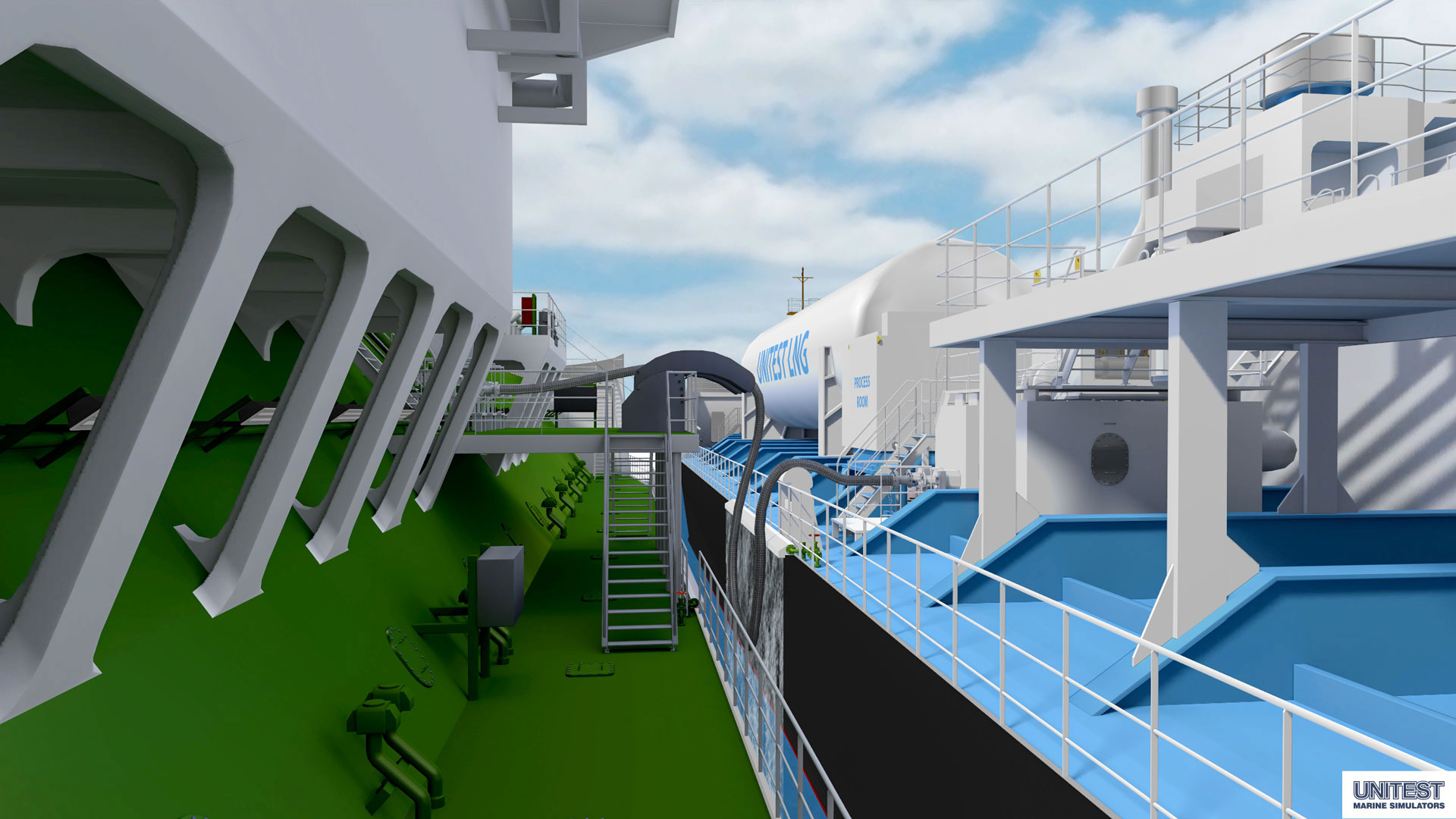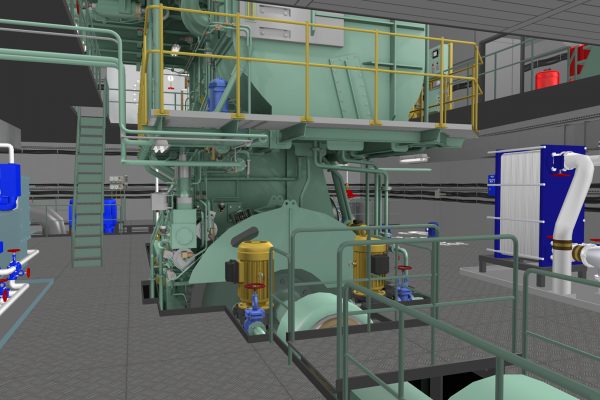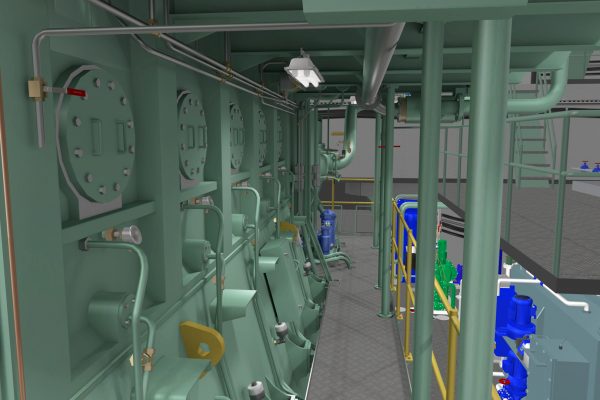W-Xpert RT-flex50DF Engine Room Simulator is based on typical solutions and presently used in medium engine rooms such as LNG carriers, handy size tankers and bulk carriers, as well as feeder container vessels. The propulsion machinery is based on Dual Fuel Electronically Controlled Winterthur Gas and Diesel RT-flex50DF, low speed, 5 cylinder configuration, 2-stroke, turbocharged engine with Controllable Pitch Propeller. The technology is based on the low pressure gas system concept which fulfils IMO Tier III emission. The electric power plant includes three (3) diesel generators and one (1) emergency generator.
The simulator is designated for training marine engineers, students of maritime academies as well as for different types of marine vocational training centres. The simulator introduces 3D model of Engine Room, has universal features and gives realistic hands-on experience in ship environment. All diesel generator engines, propulsion plant and equipment behaviours are based on real respond.
LNG bunkering model
3W-Xpert RT-flex 50DF Engine Room Simulator brochureLNG bunkering modelUnitest RT-flex50DF Engine Room Simulator is designed for training all LNG procedures such as: LNG tanks preparation (inerting and cooling down), LNG bunkering from different sources, LNG feed gas system preparation and Main Engine fuel change over procedures.
LNG bunkering procedure can be trained in the following situations:
- shore to ship;
- truck to ship;
- ship to ship.
Model description
W-Xpert simulator offers a detailed simulation of Dual Fuel engine behaviour in regards to operational aspects, its functionality and performance. The simulator includes the following systems: Power Management System which contains all standard functions, such as load dependant start/stop, load sharing, synchronising, and load shedding.
The Alarm and Monitoring System allows the operator to control all propulsion system equipment parameters.
The Intelligent Combustion Monitoring system for continuous pressure measurement and analysis of NOx emission level and FOC (Fuel Oil Consumption) with primary features includes: graphic presentation of PT, PV and Balance Diagrams, together with Mean Indicated Pressure and Maximum Pressure deviation limits. Calculated values of Effective Power, Mean Indicated Pressure pi, Compression pressure pcomp, Maximum pressure pmax and Scavenge pressure pscav include values for fuel injection and exhaust valve adjustment.
The simulation and scenario editor mode for training emergency operating procedures when faults occur on low-speed main engine, supporting systems and auxiliary machineries.
The main purpose of the simulator is the practical preparation of the trainee for engine room operation, and more particularly:
- familiarization with electronically-controlled common-rail technology and flexibility of the fuel injection and exhaust valve operations;
- familiarization with the engine room installation (electric power plant system, compressed air system, fresh and sea water cooling system, lubricating and fuel oil system);
- acknowledgment with diesel generators and auxiliary equipment starting procedure;
- propulsion system manoeuvring;
- power management system operation PMS.
To meet the requirements
W-Xpert RT-flex50DF engine room simulator has been developed to comply with STCW Code:
- Section A-1/12 and Section B-1/12,
- ISM Code: Section 6 and Section 8.
Plants overview
All operations in W-Xpert simulator can be done in specific system installation and compartments. Each system is presented as a real vessel’s schematic drawings/compartment with ability to control on screen. The most important components of the scheme can be zoomed and ed to a proper location in Engine Room to operate.
Example view of the virtual Intelligent Combustion Monitoring interface- the sitution shows one cylinder not firing. Barographs are visualising calcutated by the thermodicnamic model specific fuel consumption and NOx emission deviation in relations to the reference conditions.
CPP performance diagram
W-Xpert RT-flex50DF main features:
- Highly realistic simulator for engine room training. All engines and propulsion plant behaviours are based on real respond. In order to create the impression of working in the real environment, it provides 3D sound which can be listened to on 2, 4 or more speakers.
- Familiarization with electronically-controlled common-rail technology and flexibility of the fuel injection and exhaust valve operations which allow users to improve the combustion process in various revolution ranges.
- The thermodynamic model offers visualisation of cylinder pressures, sfoc and emissions depending on virtual operating conditions.
- The mathematical model simulates ship’s main propulsion plant, low speed, 5 cylinder, 2-stroke, turbocharged and reversible dual fuel diesel engine.
- Controllable pitch propellers allow operator to make effective and optimal use of the characteristics of the main engine in line with the ship’s purpose. The mathematic model offers visualisation of CPP performance.
- All vital auxiliary systems have been implemented.
- The user interface includes virtual controls and alarms that create a very realistic environment. The 3D virtual reality with active valves, tank level indicators and selected digital gauges enable comfortable engine room operation and monitoring. Zoom function allows navigation in 3D environment and easy access to details.
- Multichannel digitized sound provides a very realistic engine room feel. The sound effects include: engine sound correlated with engine speed, the sound of a diesel generator starting and running sound, alarm and machine telegraph buzzers. Emergency procedure training includes fire simulations.
- Operations related to drivers subsystems including valves operations and all auxiliary equipment (pumps, coolers, purifiers, etc.).
Drives operations from the following stations:
- Control from bridge: Navigation bridge console panels allow for operating propulsion plant.
- Engine Control Room: Operation of fire pumps, water mist system, control of propulsion plant. Main switchboard located in ECR compartment allows operator to control all auxiliary equipment.
- Local Control of Engine Room equipment: Main Engine and Diesel Generator Local Operation Panels.
- Starting and Control air compressors, Fuel filters, Electric motors and Fan starters, Boiler and more.
- Learning engine room typical operating routines.
- Engine room operation training. The user will have the possibility to accomplish any operational task starting from different set-ups, both pre-prepared and saved by a user.
- Corrective action learning when faults occur. Different faults can be simulated and mixed in the run-time or loaded from disk.
Main Engine Data
Type: Winterthur Gas & Diesel RT-flex50DF
Cylinder bore: 500 mm
Piston stroke: 2050 mm
Stroke/ bore: 4.10
No. of cylinder: 5
No. of air coolers: 1
No. of Turbochargers: 1
Engine Speed: 99-124 RPM
Mean effective pressure: 17.3 bar
To meet the requirements:
Engine Room Simulator has been developed to comply with STCW Code:
- Section A-1/12 and Section B-1/12
- ISM Code: Section 6 and Section 8




















